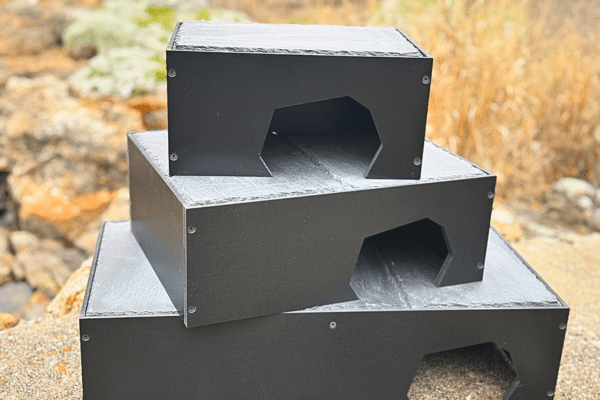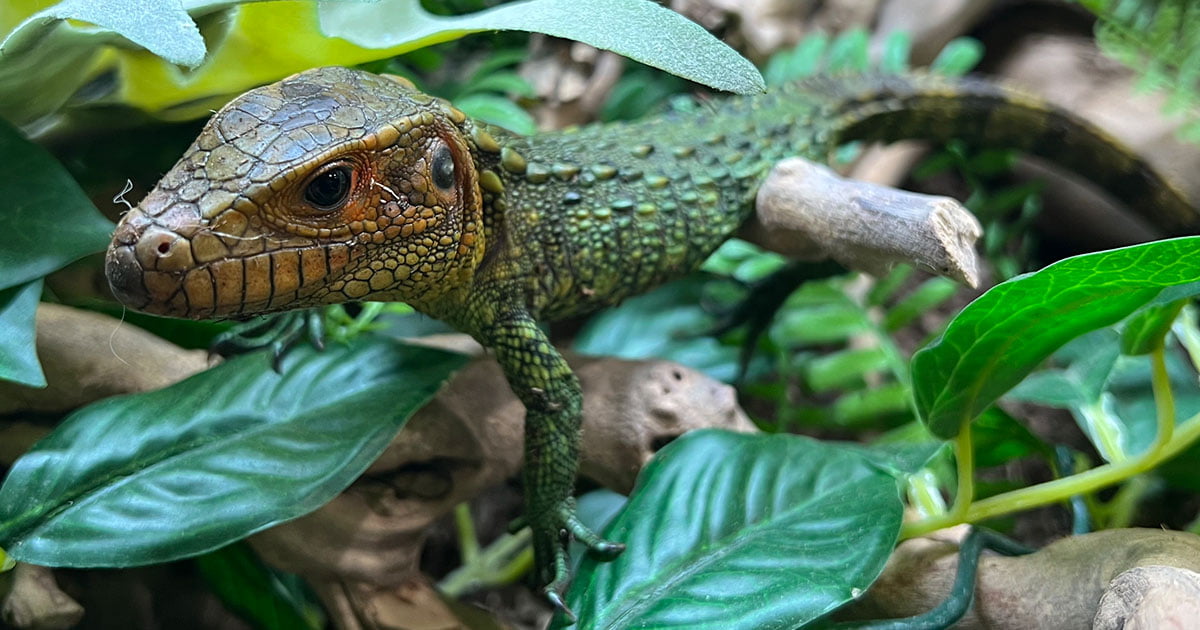Should we be providing wind in our reptiles’ enclosures? As mentioned in my interview with the Project Herpetoculture podcast, I believe that improving air quality is the next big thing in improving reptile husbandry. Here’s why:
Decreases the risk of humidity spikes. Have you ever thought about how bearded dragon communities claim that this species can’t tolerate periods of high humidity, or that an overturned water dish will kill a rosy boa, yet these animals somehow survive rainy days and hanging out in humid burrows in the wild? The difference is fresh air. Your hair dries faster outside on a breezy day than if you’re sitting around indoors — similarly, a breeze in a reptile’s enclosure helps the animal weather spikes in humidity without harm.
Discourages mold growth. If condensation is frequently seen on your enclosure doors, that’s actually a sign of poor ventilation, and not a good thing! This lingering moisture encourages the growth of mold and bacteria, which absolutely love a consistently moist environment. Mold is particularly well known for creating a toxic indoor environment. The CDC notes that while some people are more sensitive to mold than others, mold is known to irritate mucus membranes, cause difficulty breathing, and even promote chronic headaches. Early exposure to mold in children has been linked to increased likelihood of asthma, a chronic respiratory disorder.
Reduces bacteria concentration. A 2019 study on tuberculosis, a bacterial infection, found that increasing air turnover in a space via improved ventilation significantly reduces transmission rates. The effect is the same for reptiles and the potentially pathogenic bacteria in their environment. By reducing the amount of bacteria present in an enclosure, you reduce their likelihood of contracting bacterial illnesses like respiratory infections. It also increases their rate of recovery from illness by preventing re-infection. Of course, a hygienic enclosure also plays an important role here, but we should beware of relying on sterile conditions to keep our pets healthy. If an animal (including humans) must be kept in a completely sanitized environment to maintain good health, then is it actually healthy? Given that only the most sick humans are required to live in hospital-grade “bubbles” long-term, my conclusion is no.
Reduced concentration of VOCs. Plastic and other artificial materials are notorious for slowly leaking VOCs (volatile organic compounds) into their surrounding environment. Consider your reptile’s enclosure: are you using artificial décor items, particularly anything made from plastic? Although some plastics are substantially more heat- and UV-resistant than others and therefore emit little to no VOCs, others are ready sources of indoor air pollution (I’m looking at you, craft store plastic plants). Of course, your home likely has plenty of its own VOCs from paint, carpet, furniture, cleaning supplies, cosmetics, etc. (New York Department of Health), so increasing ventilation alone may not actually resolve this problem. Combining increased enclosure ventilation with a good air purifier designed to tackle VOCs, however, is likely to be beneficial to reptiles and humans!
Reduced carbon dioxide concentration. Humans and reptiles have plenty of differences, but we also have plenty of similarities; for example, the fact that we both require a certain concentration of oxygen to survive and function well, and are essentially poisoned by high levels of carbon dioxide in our environment. Exposure to too much carbon dioxide causes drowsiness, poor concentration, and generally impaired cognitive function (Allen et al., 2016; Strøm-Tejsen et al., 2015). Adding live plants to a reptile enclosure can also help with this problem, as plants “inhale” carbon dioxide and “exhale” oxygen.
Lower ambient temperatures. Struggling with uncomfortably high temperatures on your enclosure’s cool side? That means the hot air generated by your reptile’s heat lamp(s) is having trouble escaping. While some species of reptiles do enjoy a consistently warm environment, providing a wide temperature gradient is important to allowing them to regulate their body temperature, utilizing areas of warm and cool as their body demands.
Grow stronger plants. According to Michigan State University, when plants get pushed around by wind, they release a hormone which encourages the plant to reinforce itself, making it stronger than those raised in a still-air environment. Considering that a common complaint about live plants in reptile terrariums is that they get flattened by the animal inhabitant (of course, if the animal is too large for its plants, that may be a sign your enclosure needs to be taller or even topless, but that’s a topic for another day), your plants can use all the strengthening they can get! Of course, it is worth acknowledging that being harassed by your reptile will also help strengthen the plant, but too much movement will only harm the plant, not make it stronger — kind of like overdoing it at the gym only succeeds in making you horrifically sore rather than swole.
Have I made my point yet? Tl;dr: As long as you’re still meeting your reptile’s species-specific needs for average humidity, active air circulation in a reptile enclosure is likely to improve your pet’s health and wellbeing.
Don’t get me wrong, I get it — the last thing you want is another electrical device to add to your power supply. When you’re already running a couple of heat lamps, a UVB lamp, an LED, and then maybe an automatic misting system or humidifier, adding a fan to the mix isn’t exactly the most appealing prospect. However, if that fan has a USB cable instead of a standard power cord and you’re using a power strip which includes USB ports, well…



